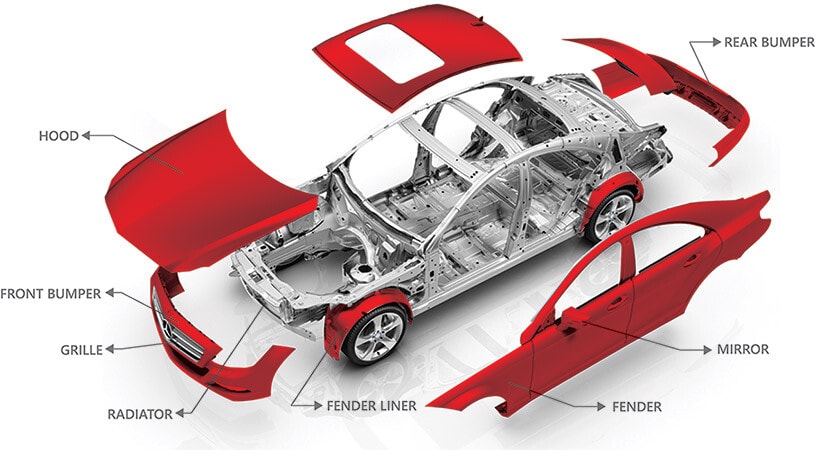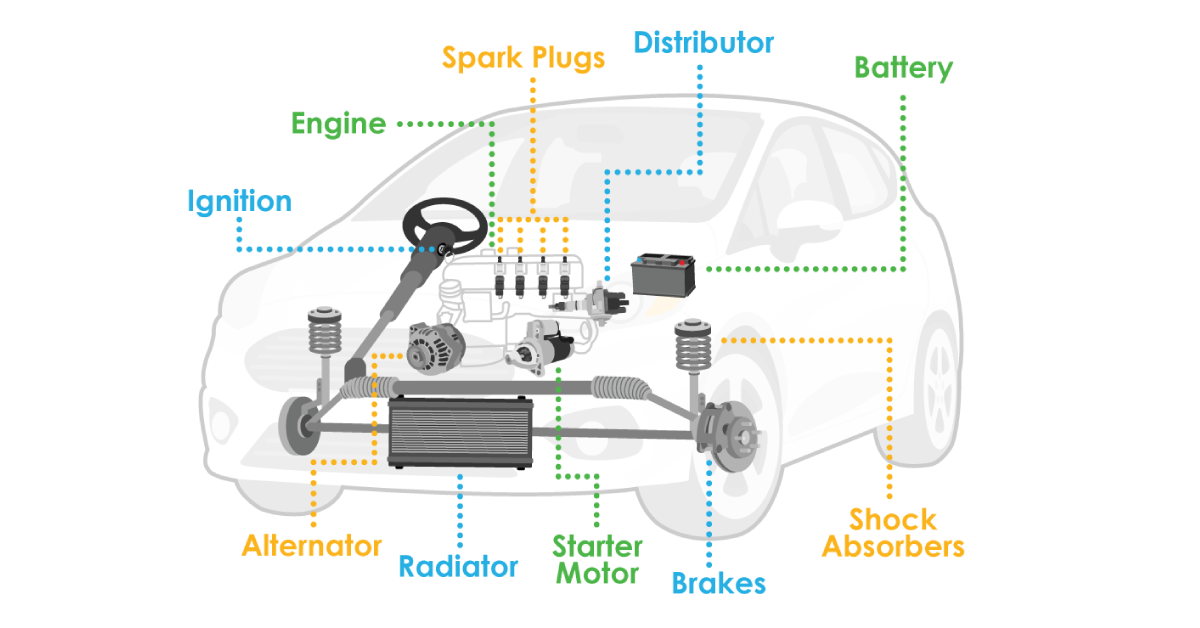20 Excellent Ideas For Deciding On Car Parts
20 Excellent Ideas For Deciding On Car Parts
Blog Article
Ten Ways To Evaluate The Quality And Authenticity Of Auto Parts
Here are some key guidelines to help you assess the quality of the auto parts and their source along with their advantages and disadvantages.
1. Choose OEM vs. Aftermarket
Select OEM (Original Equipment Manufacturing) or aftermarket components.
Pros:
OEM parts ensure a perfect fit and performance.
High-quality aftermarket parts are usually affordable.
Cons:
OEM parts are often more expensive.
Some aftermarket parts are less durable in comparison to OEM parts.
2. Verify certifications and standards.
Tip: Look for parts that have been certified by organizations such as SAE, ISO, or TUV.
Pros : Ensuring safety and compliance.
Pros: Parts that are certified may be pricier and harder to find for older vehicles.
3. Find out about the reputation and quality of a Manufacturing Company
Tips: Select well-known brands that have a track record of achievement.
Pros Lowers the chance of faulty, inefficient parts.
Cons: Some trusted brands are copyright products available Therefore, you should be extra vigilant.
4. Shop with Trusted Retailers
Buy parts only from authorized dealers as well as reputable online platforms.
Pros: Reliable retailers often offer warranties and a guarantee of quality.
The downside is that prices could be higher compared to unverified third-party sellers.
5. The construction material and quality should be examined
Tips: Make sure to use durable materials and that the construction is sturdy.
Cons: Does not provide long-lasting performance or safety.
Pros: Online parts might not be inspected before purchase.
6. Consider Refurbished or Remanufactured Parts
Refurbished options are a fantastic option for expensive components such as engines and transmissions.
Pros : Cost efficient without sacrificing quality when it is sourced from reliable suppliers.
Cons: The quality is not predictable based on the procedure of refurbishing.
7. Beware copyright products
Verify the part numbers as well as logos on packaging in order to verify that they are genuine.
Benefits: Helps to prevent installing dangerous or unsuitable parts.
Cons: Detecting counterfeits is complicated and requires expertise.
8. Make sure you check for warranty
Tip: Prioritize parts with an assurance to cover damages or failures.
Pros: Peace of mind and financial security.
Cons: Filing warranty claims may take time if problems occur.
9. Review customer feedback and ratings
Online reviews can provide important details about the performance, durability and the fitment of a product.
Pros helps identify reliable and subpar products.
Con: Some reviews are biased or not reliable.
10. Learn about regional variations in quality
Tip: Be aware of the fact that parts produced in different regions could have different quality standards.
Benefits: You will get the best possible quality for your target market.
Cons: High-quality imports may be more expensive or come with longer time to deliver.
Final Thoughts: Weighing the Benefits and Cons
Pros:
Good quality components provide the safety, reliability, and durability.
Reputable sources reduce the risk for copyright parts, or warranty issues.
Cons:
The cost of high-quality components is greater upfront.
It takes a long time to verify for authenticity and ensure quality.
When you consider both quality and the source of the vehicle, you can make intelligent purchase choices that will guarantee your vehicle's efficiency and value over time. Check out the top akumulatori car parts par avia cars for website examples including auto parts by part number, auto spares, motor spares logo, parts lv, aut9 parts near me, parts to parts, about auto parts, auto exterior parts, the auto salvage, auto 2 parts and more.
Costs And Budgets Of Automobile Parts Ten Points To Think About
When purchasing auto parts, price and budget are key elements to be considered. This is a comprehensive guide that provides 10 essential tips along with their pros, cons, and advantages
1. Budget in a realistic way
Tip: Calculate the amount you are willing to spend on the component. Make sure you balance quality and need.
Cons: Keeps expenses under control and prevents overspending.
Cons Budgets that are tight can lead to compromises in quality or durability.
2. Find Market Prices
Compare the prices of several sellers, including online retailers as well as local shops and dealerships to negotiate a fair price.
Pros: Helps to determine reasonable pricing and helps avoid overpaying.
Cons: Time consuming especially for components that are rare.
3. Know the price difference between OEM and aftermarket Parts
Tip. OEM parts can cost you more, but ensure compatibility. However, aftermarket components may be less expensive.
Cons: Provides a range of budget-friendly options.
Cons: Cheaper aftermarket parts could be less durable or lack a perfect fit.
4. Beware of Cheap Prices
If you see items that are priced extremely low it could be a fake, low-quality, or old products.
Benefits: Reduces risk of injury and unnecessary expenses.
Cons: You may end up spending more money in the beginning if you overreact.
5. Costs of Installment to Be Considered
When preparing your budget, think about the expense of professional installation along with additional tools and the materials.
Benefits: Avoids underestimating total costs.
Cons: May make seemingly cheap parts more expensive than originally anticipated.
6. Find Coupons, Discounts, and other deals
TIP: Take advantage of seasonal sales discount on bulk purchases, seasonal sales, or promotions from trusted sellers.
Cons: Lowers overall costs while securing top-quality components.
Cons: Special offers may force you to rush into choices.
7. Take into consideration the long-term value
Tip - Investing in durable quality, high-end parts might cost more upfront, but will pay off over the course of time.
Reduces the requirement for replacement and associated cost.
Cons: Initial costs that are high can put pressure on your budget.
8. Think about Refurbished or Rebuilt options
Refurbished or rebuilt parts can be an affordable alternative for noncritical components.
Pros: Not as good as brand new, but offers significant savings.
Cons: Quality and longevity depend on the vendor's reputation and rebuild process.
9. Include shipping and return cost
You should always consider the cost of shipping, taxes, and the possibility of returns when you purchase online.
Benefits: It gives a clear view of the overall cost.
Cons: Shipping fees are expensive, which may make the savings on the item appear less attractive.
10. Quality and affordability
Do not make your decision solely on the basis of cost. Pick parts that provide an ideal blend of price quality, performance, and cost.
Pros: Buy reliable parts that are within your budget.
Cons: Takes the time and effort to determine the most value-for-money choices.
Final Thoughts: Reviewing the pros and cons
Cons of Prioritizing Budget and Pricing:
Allows for better financial planning and avoids spending too much.
Encourages comparison of vendors to discover offers that are competitive.
It helps avoid costly expenses Avoids unnecessary expenses, like overpriced or unsuitable parts.
The negatives of overprioritizing or overlooking Pricing:
If budget is the primary goal, quality may be sacrificed.
In the end the end, focusing on costs only will result in costly replacements or repair.
You can extend your budget if underestimate additional costs, such as shipping and installation.
These guidelines will help you achieve the perfect balance of the quality of your product and its affordability, resulting in the purchase of a car part a more informed and educated decision. Follow the recommended protec piedevas parts for mazda cars for website tips including parts & parts, this and that auto salvage, bmw auto salvage, auto 2 parts, parts by vin bmw, at auto parts, spare part auto, the auto salvage, to auto parts, pv auto parts and more.